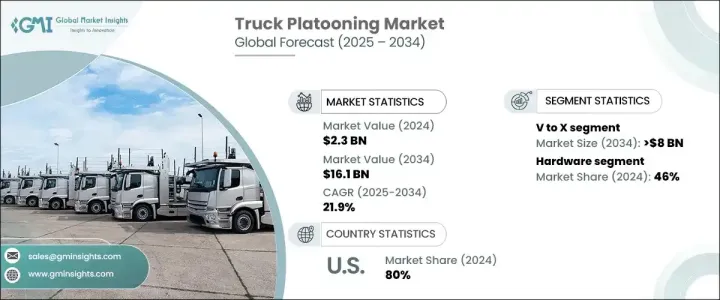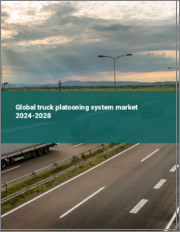
|
시장보고서
상품코드
1684805
트럭 플래투닝 시장 기회, 성장 촉진요인, 산업 동향 분석, 예측(2025-2034년)Truck Platooning Market Opportunity, Growth Drivers, Industry Trend Analysis, and Forecast 2025 - 2034 |
||||||
세계의 트럭 플래투닝 시장은 2024년에 23억 달러에 이르렀고, 2025년부터 2034년에 걸쳐 21.9%의 연평균 복합 성장률(CAGR)을 나타내 견조하게 성장할 것으로 예측되고 있습니다.
세계가 지속가능성, 업무 효율성, 안전성을 중시하게 되면서 트럭 플래투닝이 급속히 보급되고 있습니다. 여러 트럭이 밀접하게 동기화된 대열을 짜고 주행하는 이 혁신적인 기술은 연료 소비를 줄이고 환경에 미치는 영향을 최소화하는 중요한 솔루션이 되고 있습니다. 공기 저항을 줄임으로써 플라툰은 연료 비용을 크게 줄이고 이산화탄소 배출량을 줄입니다.

동시에 인공지능(AI)과 머신러닝을 포함한 자동화 기술의 진보로 더 높은 효율성과 신뢰성을 요구하는 플릿 오퍼레이터에게 플래툰은 실현 가능한 옵션이 되고 있습니다. 각국 정부는 이 첨단기술의 개발을 촉진하는 인센티브를 제공하고 연구 프로그램에 자금을 제공함으로써 시장의 성장에 기여하고 있습니다. 인프라 업그레이드 및 규제 지원도 채용을 뒷받침하고 있으며, 트럭 플래투닝은 미래 운송의 중요한 구성 요소가 되고 있습니다.
| 시장 범위 | |
|---|---|
| 시작 연도 | 2024년 |
| 예측 연도 | 2025-2034년 |
| 시작 금액 | 23억 달러 |
| 예측 금액 | 161억 달러 |
| CAGR | 21.9% |
트럭 플래투닝 시장의 주요 촉진요인 중 하나는 정부와 민간 부문 모두의 지속적인 지원입니다. 트럭 운송 업계에서 자동화로의 전환은 업무를 간소화하고, 연료비를 줄이고, 도로 안전성을 높이는 최첨단 기술의 채택을 상용 플릿으로 촉구합니다. 물류 최적화에 대한 수요가 증가함에 따라 트럭 플래투닝은 인간 운전자에 대한 의존도를 줄이면서 효율성을 향상시키는 것을 목표로하는 사업자에게 이상적인 솔루션을 제공합니다. 또한 E-Commerce의 성장과 배송기한을 지켜야 한다는 압력이 안전성을 확보하면서 속도를 높이는 방법을 모색하도록 운송사업자에게 촉구하고 있으며, 플래토닝의 채용을 더욱 뒷받침하고 있습니다.
시장은 통신기술별로 구분되며, 차차간(V2V), 차차간(V2X), 차차간 인프라(V2I)를 포함합니다. 2024년 V2X 부문은 시장 점유율의 40%를 차지했으며 2034년까지 80억 달러를 창출할 것으로 예상됩니다. V2X 기술은 플래토닝 트럭과 도로 시스템, 교통 신호 및 기타 차량과 같은 주변 인프라 간의 원활한 통신을 가능하게 함으로써 이러한 성장에 박차를 가하고 있습니다. 이 실시간 데이터 교환은 차량의 협조를 최적화하고, 특히 상호 연결된 도로에서 플래토닝을 더욱 안전하고 효율적으로 만듭니다.
트럭 플래투닝은 하드웨어, 소프트웨어 및 서비스에 크게 의존합니다. 2024년 시장의 46%를 차지한 하드웨어 부문은 큰 성장을 이루고 있습니다. LiDAR, 레이더, 카메라 및 초음파 센서를 포함한 고급 센서는 부드럽고 안전한 플래툰 운행을 보장하는 데 필수적입니다. 이 기술은 트랙이 정확한 거리를 유지하고 장애물을 감지하고 움직임을 동기화하는 데 도움이되며 하드웨어를 트럭 플래투닝 시스템의 지속적인 개발에 중요한 구성 요소로 만듭니다.
미국의 트럭 플래투닝 시장에서만 2024년 세계 점유율의 80%를 차지했습니다. AI 알고리즘과 센서 기반 자동화의 지속적인 진화를 포함한 자율주행차 기술의 미국 리더십이 플래토닝 시스템의 채용을 가속화하고 있습니다. 자율 주행 트럭의 신뢰성이 높아짐에 따라 미국의 함대 운영자는 연료 비용을 줄이고 물류를 간소화하고 교통 안전을 강화하기 위해 플래토닝 기술의 채택을 늘리고 있습니다. 자동화의 지속적인 진보로 미국 시장은 장기적으로 크게 성장하는 태세가 갖추어지고 있습니다.
목차
제1장 조사 방법과 조사 범위
- 조사 디자인
- 조사 접근
- 데이터 수집 방법
- 기본 추정과 계산
- 기준연도의 산출
- 시장추계의 주요 동향
- 예측 모델
- 1차 조사와 검증
- 1차 정보
- 데이터 마이닝 소스
- 시장 범위와 정의
제2장 주요 요약
제3장 업계 인사이트
- 생태계 분석
- 하드웨어 제공업체
- 소프트웨어 제공업체
- 서비스 제공업체
- 기술 공급자
- 최종 사용자
- 공급자의 상황
- 이익률 분석
- 기술과 혁신의 전망
- 특허 분석
- 주요 뉴스 및 이니셔티브
- 규제 상황
- 이용 사례
- 영향요인
- 성장 촉진요인
- 상용차 판매 확대
- 차량의 운행 비용과 연료 소비를 삭감하는 수요 증가
- 커넥티드카에 대한 수요 증가
- 엄격한 환경 규제와 교통 안전에 대한 수요 증가
- 기술과 하드웨어의 고비용
- 인프라 부족
- 업계의 잠재적 위험 및 과제
- 물류 관리 부족
- 국경을 넘은 운송에 수반하는 위험
- 성장 촉진요인
- 성장 가능성 분석
- Porter's Five Forces 분석
- PESTEL 분석
제4장 경쟁 구도
- 서론
- 기업 점유율 분석
- 경쟁 포지셔닝 매트릭스
- 전략 전망 매트릭스
제5장 시장 추계·예측 : 구성 요소별(2021-2034년)
- 주요 동향
- 하드웨어
- 센서
- 감지 시스템
- 카메라
- 기타
- 소프트웨어
- 서비스
제6장 시장 추계·예측 : 차량별(2021-2034년)
- 주요 동향
- 소형 상용차(LCV)
- 대형 상용차(HCV)
제7장 시장 추계·예측 : 자율 주행 레벨별(2021-2034년)
- 주요 동향
- 부분 자율형
- 완전 자율형
제8장 시장 추계·예측 : 통신 기술별(2021-2034년)
- 주요 동향
- 차량 대 차량(V2V)
- 차량 대 모든 것(V2X)
- 차량 대 인프라(V2I)
제9장 시장 추계·예측 : 지역별(2021-2034년)
- 주요 동향
- 북미
- 미국
- 캐나다
- 유럽
- 영국
- 독일
- 프랑스
- 이탈리아
- 스페인
- 러시아
- 북유럽
- 아시아태평양
- 중국
- 인도
- 일본
- 한국
- 뉴질랜드
- 동남아시아
- 라틴아메리카
- 브라질
- 멕시코
- 아르헨티나
- 중동 및 아프리카
- UAE
- 남아프리카
- 사우디아라비아
- 터키
제10장 기업 프로파일
- AB Volvo
- Bendix
- Bosch
- Continental
- Daimler
- Hino Motors
- IVECO
- NVIDIA
- Omnitracs
- Peloton
- Scania
- TomTom
- TuSimple
- Veddel
- ZF Friedrichshafen
The Global Truck Platooning Market reached USD 2.3 billion in 2024 and is projected to grow at a robust CAGR of 21.9% from 2025 to 2034. As the world becomes more focused on sustainability, operational efficiency, and safety, truck platooning is rapidly gaining traction. This innovative technology, where multiple trucks travel in a closely synchronized formation, is becoming a crucial solution for reducing fuel consumption and minimizing environmental impact. By reducing aerodynamic drag, these platoons significantly cut fuel costs while lowering carbon emissions.

At the same time, advancements in automation technology, including artificial intelligence (AI) and machine learning, make platooning a feasible option for fleet operators seeking greater efficiency and reliability. Governments are also contributing to the market's growth by offering incentives and funding research programs that promote the development of this advanced technology. Infrastructure upgrades and regulatory support are also helping drive adoption, making truck platooning a key component of the future of transportation.
| Market Scope | |
|---|---|
| Start Year | 2024 |
| Forecast Year | 2025-2034 |
| Start Value | $2.3 Billion |
| Forecast Value | $16.1 Billion |
| CAGR | 21.9% |
One of the primary drivers of the truck platooning market is the ongoing support from both governments and private sectors. The shift toward automation in the trucking industry is pushing commercial fleets to adopt cutting-edge technologies that streamline operations, reduce fuel expenses, and enhance safety on the roads. With the increasing demand for logistics optimization, truck platooning offers an ideal solution for operators aiming to improve efficiency while reducing reliance on human drivers. Additionally, the growth in e-commerce and the pressure to meet delivery deadlines are prompting fleet operators to seek ways to increase speed while ensuring safety, further boosting the adoption of platooning.
The market is segmented by communication technology, which includes Vehicle-to-Vehicle (V2V), Vehicle-to-Everything (V2X), and Vehicle-to-Infrastructure (V2I). In 2024, the V2X segment captured 40% of the market share and is expected to generate USD 8 billion by 2034. V2X technology is fueling this growth by enabling seamless communication between platooning trucks and surrounding infrastructure, such as road systems, traffic signals, and other vehicles. This real-time data exchange optimizes vehicle coordination, making platooning safer and more efficient, especially on interconnected roadways.
Truck platooning also relies heavily on hardware, software, and services. The hardware segment, which accounted for 46% of the market in 2024, is experiencing significant growth. Advanced sensors, including LiDAR, radar, cameras, and ultrasonic sensors, are integral to ensuring smooth, safe platooning operations. These technologies help trucks maintain precise distances, detect obstacles, and synchronize their movements, making hardware a critical component for the ongoing development of truck platooning systems.
The U.S. truck platooning market alone made up 80% of the global share in 2024. The nation's leadership in autonomous vehicle technology, including the continuous evolution of AI algorithms and sensor-based automation, is accelerating the adoption of platooning systems. As autonomous trucks become more reliable, fleet operators in the U.S. are increasingly adopting platooning technology to reduce fuel costs, streamline logistics, and enhance road safety. With continued advancements in automation, the U.S. market is poised for substantial long-term growth.
Table of Contents
Chapter 1 Methodology & Scope
- 1.1 Research design
- 1.1.1 Research approach
- 1.1.2 Data collection methods
- 1.2 Base estimates & calculations
- 1.2.1 Base year calculation
- 1.2.2 Key trends for market estimation
- 1.3 Forecast model
- 1.4 Primary research and validation
- 1.4.1 Primary sources
- 1.4.2 Data mining sources
- 1.5 Market scope & definition
Chapter 2 Executive Summary
- 2.1 Industry 3600 synopsis, 2021 - 2034
Chapter 3 Industry Insights
- 3.1 Industry ecosystem analysis
- 3.1.1 Hardware providers
- 3.1.2 Software providers
- 3.1.3 Service providers
- 3.1.4 Technology providers
- 3.1.5 End users
- 3.2 Supplier landscape
- 3.3 Profit margin analysis
- 3.4 Technology & innovation landscape
- 3.5 Patent analysis
- 3.6 Key news & initiatives
- 3.7 Regulatory landscape
- 3.8 Use case
- 3.9 Impact forces
- 3.9.1 Growth drivers
- 3.9.1.1 Growing sales of commercial vehicles
- 3.9.1.2 Increase in demand to reduce operating cost and fuel consumption by fleet
- 3.9.1.3 Rising demand for connected vehicles
- 3.9.1.4 Stringent environmental regulations and rising demand for road safety
- 3.9.1.5 High cost of technology and hardware
- 3.9.1.6 Lack of infrastructure
- 3.9.2 Industry pitfalls & challenges
- 3.9.2.1 Lack of logistics control
- 3.9.2.2 Risks associated with cross-border transportation
- 3.9.1 Growth drivers
- 3.10 Growth potential analysis
- 3.11 Porter’s analysis
- 3.12 PESTEL analysis
Chapter 4 Competitive Landscape, 2024
- 4.1 Introduction
- 4.2 Company market share analysis
- 4.3 Competitive positioning matrix
- 4.4 Strategic outlook matrix
Chapter 5 Market Estimates & Forecast, By Component, 2021 - 2034 ($Bn)
- 5.1 Key trends
- 5.2 Hardware
- 5.2.1 Sensors
- 5.2.2 Detection systems
- 5.2.3 Camera
- 5.2.4 Others
- 5.3 Software
- 5.4 Services
Chapter 6 Market Estimates & Forecast, By Vehicle, 2021 - 2034 ($Bn)
- 6.1 Key trends
- 6.2 Light Commercial Vehicle (LCV)
- 6.3 Heavy Commercial Vehicle (HCV)
Chapter 7 Market Estimates & Forecast, By Autonomous Level, 2021 - 2034 ($Bn)
- 7.1 Key trends
- 7.2 Partially-autonomous
- 7.3 Fully autonomous
Chapter 8 Market Estimates & Forecast, By Communication Technology, 2021 - 2034 ($Bn)
- 8.1 Key trends
- 8.2 Vehicle to Vehicle (V to V)
- 8.3 Vehicle to Everything (V to X)
- 8.4 Vehicle to Infrastructure (V to I)
Chapter 9 Market Estimates & Forecast, By Region, 2021 - 2034 ($Bn)
- 9.1 Key trends
- 9.2 North America
- 9.2.1 U.S.
- 9.2.2 Canada
- 9.3 Europe
- 9.3.1 UK
- 9.3.2 Germany
- 9.3.3 France
- 9.3.4 Italy
- 9.3.5 Spain
- 9.3.6 Russia
- 9.3.7 Nordics
- 9.4 Asia Pacific
- 9.4.1 China
- 9.4.2 India
- 9.4.3 Japan
- 9.4.4 South Korea
- 9.4.5 ANZ
- 9.4.6 Southeast Asia
- 9.5 Latin America
- 9.5.1 Brazil
- 9.5.2 Mexico
- 9.5.3 Argentina
- 9.6 MEA
- 9.6.1 UAE
- 9.6.2 South Africa
- 9.6.3 Saudi Arabia
- 9.6.4 Turkey
Chapter 10 Company Profiles
- 10.1 AB Volvo
- 10.2 Bendix
- 10.3 Bosch
- 10.4 Continental
- 10.5 Daimler
- 10.6 Hino Motors
- 10.7 IVECO
- 10.8 NVIDIA
- 10.9 Omnitracs
- 10.10 Peloton
- 10.11 Scania
- 10.12 TomTom
- 10.13 TuSimple
- 10.14 Veddel
- 10.15 ZF Friedrichshafen



















